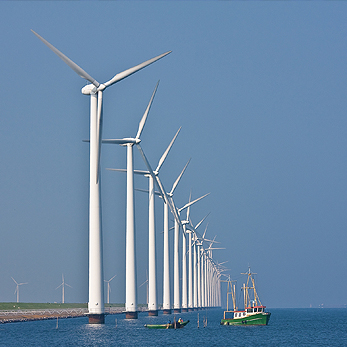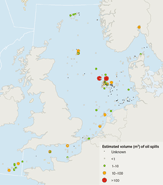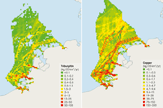Since 1998, a number of incidents have occurred in the OSPAR area involving loss of cargo (e.g. chemicals, timber, containers) and of ships. In most cases, there is limited information to assess the environmental impact of these losses. Improved controls on the securing of cargoes could work to minimise cargo loss.
Air pollution from ships is increasing
Emissions of nitrogen oxides (NOX), SOX and particulate matter from engine exhaust gases and cargo tanks may be carried long distances. Most emissions in EU sea areas are from cargo ships over 500 gross register tonnage. Around 45% of all emissions are from EU-flagged ships and around 20% of emissions are emitted within 12 miles of the coast. The total contribution of NOX from international ship traffic in the North Sea and the Atlantic was 1850 kt in 2007. This is an increase of more than 20% since 1998. Without the strict standards of the revised MARPOL Annex VI adopted in 2008, emissions from international shipping would have been expected to increase substantially. Models predict that by 2020 emissions of sulphur dioxide, NOX and particulate matter from international shipping in all EU seas would have increased from their 2000 levels by 40% (3200 kt), 45% (4800 kt) and 55% (400 kt) per year, respectively Figure 9.4. Implementing the more stringent emissions standards in the amended MARPOL Annex VI will help target air pollution and should be given high priority, particularly in light of the expected increase in ship traffic. Even stricter standards apply in designated NOX and SOX Emission Control Areas. As a SECA, the North Sea currently profits from the more stringent ship fuel regulation for SOX, but this still allows sulphur contents in fuels 15 000 times that of fuel for road vehicles. Moreover, fuel regulations under MARPOL Annex VI address only sulphur and not other polluting substances. This is a gap that needs to be closed. Despite a large amount of information on inputs via the atmosphere, there is limited understanding of the contribution of shipping to environmental impacts.
Ships also emit ozone-depleting gases (e.g. from incinerators and cooling installations) and greenhouse gases from engine exhausts and so contribute to global emissions. A recent IMO study estimates that shipping emitted 1046 million tonnes of carbon dioxide (CO2) globally in 2007, which is 3.3% of total worldwide CO2 emissions in 2007. Most of these emissions (870 million tonnes or 2.7% of global CO2 emissions) have been attributed to international shipping.
The IMO is currently working towards measures to reduce greenhouse gas emissions from shipping. The EU also targets air emissions from shipping through its 2005 Thematic Air Strategy. OSPAR countries support these initiatives.
Illegal discharges and disposal of waste are still occurring
Illegal disposal of waste (litter) from ships can be as detrimental to marine life as oil or chemicals. The greatest danger comes from plastics. Discharge of garbage is regulated through MARPOL Annex V. This prohibits the disposal of plastics anywhere into the sea, and severely restricts discharges of other types of garbage from ships to coastal waters and Special Areas. While shipping is acknowledged as a major source of marine litter it is difficult to quantify the exact amount as many litter items can be attributed to more than one source.
The effects of sewage discharges on water quality and in relation to eutrophication are thought to be minimal provided they comply with MARPOL Annex IV. In the open sea, raw sewage is assimilated through natural bacterial action, but illegal sewage discharges near the coast may be a problem locally.
Lack of data prevents assessment of port waste reception facilities
According to MARPOL, oily ballast and tank washing water, oily bilge water and wastes should be retained on board until they can be delivered to port waste reception facilities. It is difficult to identify improvements brought about by the introduction of port waste reception facilities because there are few data on the amounts and types of wastes handled. Prior to the implementation date of measures there was no reporting system in place and most waste operations in ports are contracted out to private operators which rarely report to port authorities.
TBT losses are expected to cease
There has been much progress towards the phasing out of tributyltin (TBT) Chapter 5. Following the global ban on TBT in anti-fouling systems through the IMO, the release of TBT from ships’ hulls is expected to cease with an associated decline in effects on marine species from TBT. However, losses of TBT substitutes (such as copper and Irgarol) are expected to increase. It has been estimated that ships in the Netherlands’ Exclusive Economic Zone (EEZ) collectively release up to 30 tonnes of copper into the North Sea each year, both in transit and at anchor Figure 9.5. There has been some progress in the development of non-biocidal alternatives to TBT and copper such as self-polishing surfaces and non-sticky paints.
Introductions of non-indigenous species through ballast water continue
Over 160 non-indigenous species have been identified in the OSPAR area, as reported later in this chapter. Some of the main routes for these unintended introductions are through the discharge of ballast water (and the sediments that it carries) and fouling on ships’ hulls. The risk of new species introductions is related to the amount of ballast water discharged, the frequency of ship visits and the match between environmental conditions where ballast water originated and where it is discharged. With increasing ship traffic there is a higher risk that new species will be introduced. Faster ships and shorter journey times mean that organisms have a greater chance of surviving the voyage.
Non-indigenous species can severely affect the structure of ecosystems. For example, the comb jelly (Mnemiopsis leidyi) which feeds on zooplankton and fish eggs was introduced to the Black Sea through ballast water in the 1980s and has been associated with dramatic changes in the pelagic food web and the collapse of commercial anchovy fisheries. The species was first recorded in the Netherlands, Norway and Sweden in 2006. So far, effects on the North Sea trophic structure and on fish stocks are unknown. Milder winters due to climate change are expected to favour its expansion. There is a need for OSPAR countries to ratify and implement the IMO Ballast Water Convention and to assess the risk of new species introductions.
Increasing concern over noise and ship strikes
There are growing concerns over pressure on marine mammal populations due to noise from shipping and the risk of ship strikes, especially along migration routes in Regions I, IV and V. Ship traffic has been shown to be a dominant source of low frequency noise in many, if not most, coastal zones with high ship traffic. It is estimated that there has been an approximate doubling (3 dB increase) of background noise per decade since the 1950s in some sea areas. Commercial shipping is the most probable source of this increase. The development of faster and larger ships, and growth of ship traffic have increased concern about the risks associated with ship strikes. Collisions with ships are known to be fatal for whales, especially larger species, and may be a threat to vulnerable populations in waters with high levels of shipping.
Pressures on the environment are expected to increase
Predictions for shipping for the period to 2020 are difficult, due to confounding economic factors such as oil price and geopolitical issues. However, through-traffic of oil tankers is predicted to increase with higher environmental risks in the busier shipping lanes especially in Region II. Shipping is expected to increase in Region I, where sea-ice retreat and new technology are expected to afford new opportunities for exploiting Arctic resources (hydrocarbons, minerals, fisheries). The most significant threats from Arctic shipping are oil discharges.
With growing ship traffic and vessel size, increasing pressure can be expected from dredging and dumping of sediments from shipping channels, land reclamation and the construction of port facilities. These pressures are mainly concentrated on coastal areas where increasing pressures may conflict with nature conservation objectives for areas of particular ecological value.
Continue to "Shipping - What happens next?"




